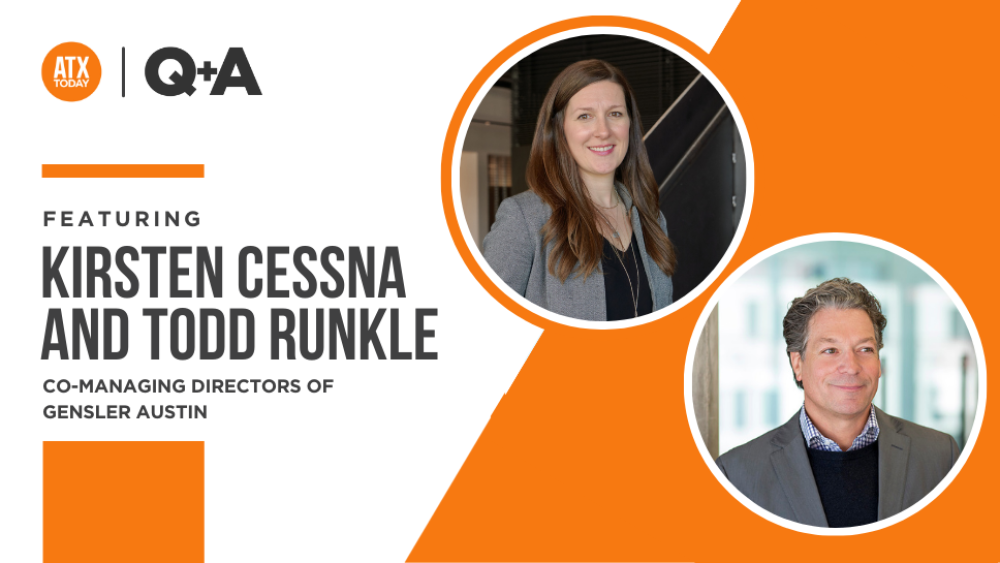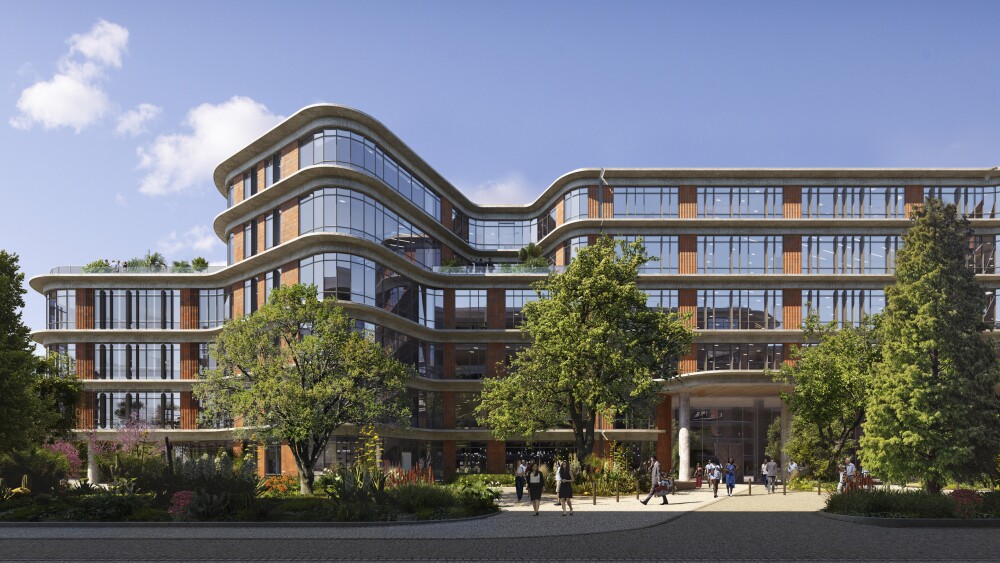The Domain Northside, the downtown Fairmont Hotel, and the Moody Center. What do they have in common? They were all designed by architecture firm Gensler.
The firm is working on several other projects with the potential to change the fabric of Central Austin, so we spoke with Co-Managing Directors Todd Runkle and Kirsten Cessna — who started the role last month — about the company’s vision.
Editor’s note: This interview has been edited for clarity and brevity.
Kirsten, welcome to the new role. Can you tell me about your background?
Kirsten: I’ve been with Gensler for eight and a half years in the Dallas office. I came in as a senior interior designer … and then I moved my way up into operations leader, and then studio director. I made principal in the Dallas office, and then they said, “Todd needs a partner in Austin.”
What I love about Gensler is … I was always pushed to really think beyond the status quo of where I could go.
Can you talk a bit about the co-leadership model?
Kirsten: It’s really about partnership, and being able to complement each other’s spaces and strengthen one another. … It allows us to identify, where do you really want to [focus], based on our strengths, and really bolster the office, and the region, and the firm in those regards?
As Todd and I were getting to know each other better and having more conversations, we saw that we complement each other very nicely in where our strengths and our interests lie.
Todd, you’ve been in the Gensler Austin office since day one. How have you seen the local landscape change since then?
Todd: I think our success has been these large, complex projects that we’ve been fortunate to solve. I think that’s really been the dynamic growth of this office. … We’ve been so successful because we have such great people here, and I know I needed a partner to help continue to grow this.
(In) Austin, as it continues to grow, some of the issues we’re dealing with are mobility, as well as multifamily growth downtown… a number of things. To me, we’re at a turning point for the city. How can we help continue to solve large, complex problems?
I think that’s our stepping stone … doing larger complex projects, but still being agile enough that we can do a law firm or we can do a technologies company, or a workplace.
What projects do you think have been the most seminal to your work in Austin?
Todd: I think the Green Water Treatment Plant redevelopment … I mean, that was the first urban master plan that we did, and that was the second project as an office we ever took on. Trammell Crow Company won the site before 2008 or 2009, and that’s when we were in a recession. The city said it was just two dense, it was too big. So we got engaged to really scale it all back.
That was a turning point. I think that was probably the City of Austin’s first Class A office building in that period of time. It was transformational and really, I think it helped define what a Class A office building in Austin, Texas is. That also helped us grow our architectural practice in terms of commercial office buildings.
So, let’s talk about some upcoming projects. What’s in the pipeline?
Todd: We did the Innovation District Master Plan, which used to be Central Health’s Campus, just on the edge of the University of Texas.
We’ve got a number of projects bridging from the Innovation District to a sports and entertainment district, kind of the merging of innovation as well as sports on UT’s campus. It’s anchored by the Moody Center and involves redeveloping that entire area along Red River, where we realigned the road and did all the infrastructure as part of the Moody Center project.
You’ll see, in the near future, a number of projects coming up that will really tie that whole area together to create this research, innovation, sports and entertainment district. I think the entire energy of Downtown is going to move toward that area.
Also, the cap and stitch on I-35, we’re heavily involved in that now, too. I think that’s equally as impactful in bridging that area of I-35 with East Austin. Springdale Green is another project in East Austin. It is a million square foot spec office building.
I think that will further transform the University of Texas, the Convention Center district and East Austin. We’re involved in a number of those projects really tying downtown Austin, the University, and East Austin all together. I think that’s huge.
How would you say the focus of Gensler Austin has changed in recent years?
Todd: Our office building work is significantly slowed down and I think it will continue to slow down to a halt. Our lifestyle work, which includes sports and hospitality and multifamily, that’s really where our focus is, not just in Austin, but really as a firm.
Kirsten: When you take the lens of everything that we do, it either touches people at work, or in their play. It’s all about impacting their experiences. We have a very impactful opportunity as architects and designers to really influence the patrons of our surrounding cities. People really have memories of those experiences.
It sounds like a lot of your current projects are centered around connection. Would you be able to speak to how that factors into your design process?
Todd: I think, coming out of all this COVID stuff, we are people who want to be closer to work, closer to entertainment, and closer to sports. As we’ve done more projects, I think people want to have hotels and places to work within a much tighter, confined zone.
I think having sub-markets in Austin is going to be the future, too. The Domain is a great example (and) I think that’s the true evolution of cities. You may have something that becomes the central business district, but then there are all of these other pockets around the city, and Austin’s just on the edge of that.
Austin’s just going to continue to grow, and hopefully we can be more thoughtful as we develop these areas.















